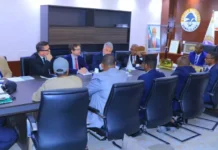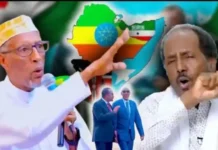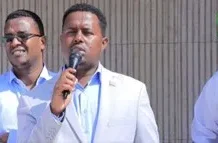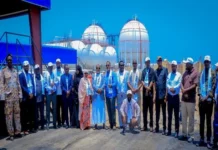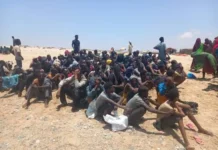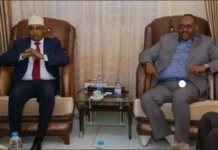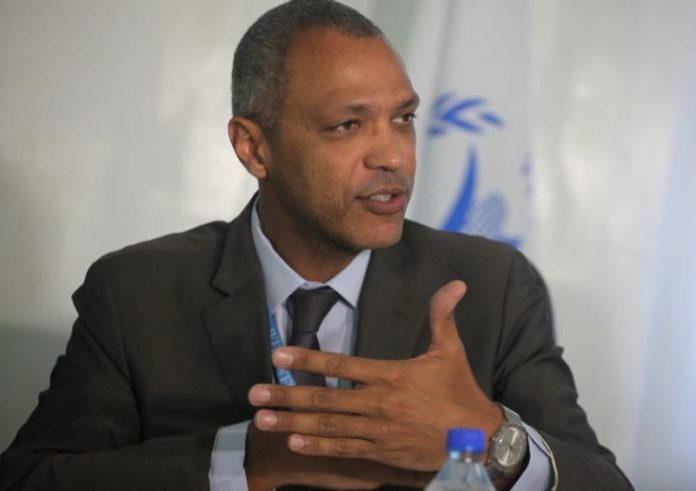UN WFP Country Director and Representative for Somalia, Laurent Bukera.
As Somalia experienced a failure of the initial portion of the Gu’ rains that are crucial for agricultural production, aid agencies have launched a Drought Response Plan calling for urgent and sustained resources to avert a major crisis.
The plan seeks $710 million to provide critical life-saving aid to 4.5 million people in the most severely-affected areas from now until the end of the year.
Below is the script of an interview with UN WFP Country Director and Representative for Somalia, Laurent Bukera.
Q: After spending years working in Somalia, what is your assessment of the situation?
When I joined World Food Programme in Somalia in 2014, I immediately travelled to various parts of the country to see the situation firsthand, and to think of how we could help to improve the situation in an effective and
efficient manner.
I saw a Somalia that was still recovering from effects of conflict and famine. I see a Somalia that is now full of promise and opportunities. The State architecture is in place, extending all the way through district levels, with district commissioners close to the people and advocating for their people. Universities are producing young graduates, all energetic and talented Somalis eager to play their part in the rebuilding efforts.
The international actors continue to play a critical role with unwavering support, persistent and tireless efforts to support Somalis improve their country. For our part, with continued support from generous donors, we will do everything we can to sustain gains made and respond during crisis to lay the foundation for a stable and prosperous Somalia.
We are working with a network of nearly 1,000 retailers to meet the needs of those we serve through the markets. To improve the food supply chain, we are focusing on food systems in order to support producers and connect them to markets, where those we support with cash or vouchers buy their food. Working with other partners, we are supporting the government to build a national social protection system, through the development of a social protection policy, a necessary foundation to establish a national system for the Somalis living in the most vulnerable situations.
Q: What are WFP’s key highlights during your five years in Somalia?
The first that comes to mind is how, together with the government, donors and implementing partners, we averted famine in 2017 and saved lives. The ‘total togetherness’ is something I will never forget.
The second is the implementation of cash programming (SCOPE system) to support the evolution of WFP evolution to cash-based transfers. This was massive and important for WFP’s evolution and for those in need.
The increased presence of WFP across Somalia, enabling us to be on the
ground and engage with local authorities, UN and NGO partners as well as
community leaders to identify the most effective and efficient ways to deliver value.
The development of the WFP Strategy for Somalia (2019-2021), in consultation with stakeholders at all levels through a series of year-long consultations. The strategy, while supporting response to shocks, is about resilience building, support to systemic changes and maintaining the compass on the ‘progress’ direction.
Above all, I have enjoyed listening to the insights and stories of people, colleagues and friends I met and engaged with during visits to many places these past 5 years.
Q: Somalia is facing another severe drought less than two years after escaping prefamine conditions. What do you think needs to be done to mitigate the impact of climatic shocks?
We need to build resilience against all odds and introduce innovative and sustainable ways to mitigate the impact of climatic shocks. The use of drip irrigation is giving amazing results. It is supporting farmers and cooperatives to grow fruits and vegetables using minimum water while saving on scarcely available water especially during drought.
Where fertile land and irrigation supports agricultural production, farmers’ cooperatives also need to be supported with post-harvest solutions to reduce food losses. Such techniques increase value of products and help them meet regional and global quality standards. Modern techniques like hydroponics, need to be introduced in Somalia as soon as possible for people to learn to use such techniques. These techniques allow plants to grow without soil, using 90 per cent lesser water than traditional techniques.
Q: How has SCOPE card transformed the delivery of aid in Somalia? What do you think is the future of cash intervention?
We introduced the use of SCOPE in 2015. Through SCOPE, we are able to carry out biometric registration of the people we assist. We use it to manage cash, nutrition and in-kind food assistance.
Cash-based transfers now make up 70 per cent of the total assistance we provide in Somalia. With these transfers we are able to give people purchasing power to choose the food they like and buy from shops, like anyone else, thus bringing a sense of normality even during crisis. Cash-based transfers help boost the local economy and empower communities. We are working with nearly 1,000 retailers across the country.
For many of those receiving WFP assistance, a SCOPE card is a step towards financial inclusion, through which people interact with shops and financial institutions, retaining the control over their money. This is because only the card owner can sign-in biometrically to access goods or money they have received.
This is particularly meaningful for the displaced people who lose everything when they leave their villages. Cash-based transfers have helped lay the foundation for the implementation of safety net systems and I believe this will inform a future social protection system in Somalia. Given the positive impact of cash-based transfers in Somalia, I can see more agencies providing such transfers in an ever more structured manner where markets are in place.
Q: Given the recurrence of climatic shocks and their severe impact on Somalis, what do you think needs to be done to balance life-saving and resilience building in addressing the drivers of the crisis?
Drought, floods and other climatic shocks are now a feature of climate change not only in Somalia but also across the world. As Somali communities become more resilient, they also get better at adapting to climatic shocks and coping with crisis. But we need to do more.
Climatic shocks should not result in crisis and should not push people in the kind of desperate situations we have seen again with the current drought. Maintaining our ability to respond during crisis, while focusing on resilience and long-term development investments, is the only solution. For now, and until development actions’ dividends are realized, it is neither ‘one or the other’. It is all about saving lives today – and – building a better tomorrow.
Q: How do you see the future of Somalia in terms of food security and resilience building?
Challenges are real and multiple with severe consequences on the lives of Somalis living in the most vulnerable circumstances. But I am an optimist and I believe Somalia’s future is happening now – with the tireless engagement of Somalis and all the work of aid actors, the positive trajectory will continue.
With it, the result of smart production, smart entrepreneurship, etc. I believe that within a decade, we will see a stable Somalia with resources to meet the needs of its people. A Somalia where social services, quality life and, sufficient and good food for all will be a reality for every person.


